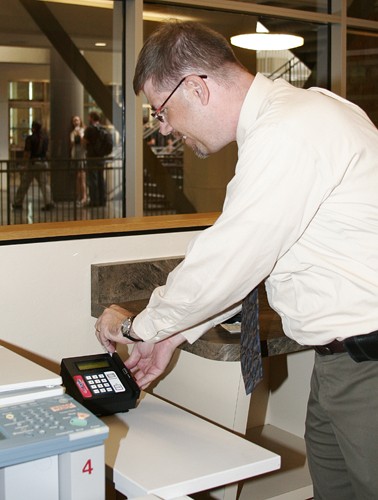The Cash-to-Chip machines around campus have been replaced by CatCash, a new service that allows students to pay for services other than food with their card.
There will be 50 printing stations in total that offer the option of paying with CatCash. The service also covers being able to swipe your card to pay for parking in all garages, prints from Fast Copy, buying a fitness pass at the Student Recreation Center and much more.
“”It’s basically the new way to pay for non-food purchases on campus,”” said Joel Hauff, the associate director for facilities and operations for the Arizona Student Unions.
Though the change is slow and not many students are aware of the CatCash card yet, soon everybody will be required to use it as old resources will be removed.
“”It’s kind of an implementation as you go, but soon it’s going to be the only option,”” Hauff said.
Most students who were at the student union had no idea what it was, or had even heard about it.
Money in a CatCash account also rolls over every semester.
“”This account will always roll over, even to the next year, unlike the plus meal plan that expires at the end of a semester,”” said Amanda Percy, the supervisor of the Meal Plans Office.
Percy said the CatCash system uses the same system as the meal plan. It hasn’t been that popular yet, but according to Percy, “”the word is just getting out to students this week.””
Students can also use a credit card to put money into their account.
“”It goes in immediately, and what’s nice about that is you can do it from any computer anywhere in the world,”” Hauff said. “”Whereas you used to have to find the little machines on campus to put money on your chip.””
There will be a limit to how much money students can put on their cards, though.
“”Most people don’t really know, but we’re setting a limit soon at around $200,”” Percy said. “”We don’t think students would really need more than that.””
If students still have money left on their chip, they can go to the Meal Plans Office and ask to have their funds transferred over.
Hauff said garage payments, print copies, and some special art and architectural labs are examples of things CatCash can be used for.
The CatCash installment came about because the CatCard offices knew they were going to have to reinvent the card, according to Hauff.
“”They had to move away from the smart chip, and we are moving towards a contact list chip,”” he explained. “”As they were making the technological switch, we knew there were some challenges with the way the old program worked that we had to get by.””
Hauff said the hardest part of developing CatCash was the concept.
“”Coming up with marketing material was difficult because we needed it to make sense to students, faculty and staff. We did some research, tested different brand names and checked with students first.””
Another challenge they came across was technology.
“”It’s a huge implementation — lots of challenges and adjusting little things. We had lots of struggles and our team spent a ton of time making little changes and adjusting little bugs,”” Hauff said.
The CatCash went live for the first time on Tuesday. Its team is comprised of workers from the CatCard office, the student unions and the libraries. Funds came directly from the CatCard offices.
“”They anticipated that a change like this was coming, so they had been saving money from their annual budget to pay for this transition and technology put into the implementation of CatCash,”” Hauff said. “”Since the unions were already doing this type of account for meal plans with the CatCards that already had a system in place, we are just transitioning the responsibility from them to the unions. We’re now responsible for CatCash.””
If a student were to lose their CatCard, it can be deactivated on the meal plan website, at their office in the student union or at catcash.arizona.edu.









